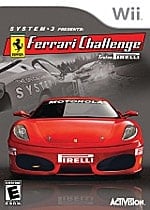Let’s start with what Ferrari Challenge: Trofeo Pirelli is not. It is not an action-packed, edge-of-your-seat, just-pick-it-up-and-play racer. In the long run, it will (hopefully) not be the end-all, be-all of racing simulators on the Wii, either. And it is not, quite frankly, very much fun.
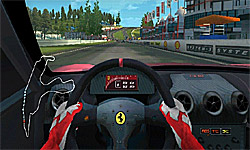
It is, however, the most unrelentingly realistic racer the console has seen so far, and there are a whole bunch of Ferraris to drive. If that sounds like a blast, Ferrari Challenge contains hour upon hour of entertainment.
Most players, even those used to controlling a car or go-kart with the Wii-mote or Wii Wheel, would be well-advised to try the in-game tutorial before tackling the race modes. Here, voice recordings from British racer Tiff Needell walkthrough the basics of control, and a drive around Fiorano, the Ferrari test circuit, gives players time to soak up the scenery and get a hang of driving.
The graphics are decent – for the Wii, which is always the important qualification. As usual, the game looks a bit pixelated on some HDTVs (even in 480p with a component cable), and it’ll do nothing to prevent longing looks at screenshots from the PlayStation 3 version.
Still, there are some nice touches. The landscapes look good, though the trees can seem two-dimensional. Players can switch perspectives with the minus button, and each view features some well-done effects. From behind the vehicle, the car’s shiny exterior reflects the surroundings, and in the first-person “cockpit” perspective (which for some reason takes away the speedometer), when driving under trees, it actually looks like the shadows pass over the TV.
Sound-wise, Ferrari Challenge presents a mixed bag. The engine roars satisfy, but the crashes sound far short of jarring. The music is a rather quirky blend of dance, techno, and hip-hop, and it’s quiet enough that, during races, one hardly hears it.
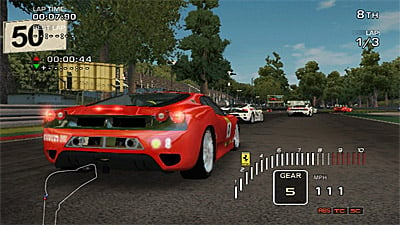
From the tutorial’s first seconds, it’s clear that Ferrari Challenge is indeed a challenge. At high speeds, it’s not possible to turn the wheel very far (in the first-person view, it’s a little odd to crank the controller 90 degrees, while the wheel on the screen barely budges), so before hitting corners, constant and hard braking is a must.
Relative to a bare controller, the Wii Wheel has an edge in the realism department, but the control scheme only uses the B button (the trigger on the back that’s awkward to press without the Wheel) for the rear-view, so there’s no real tactical advantage to the accessory. Also, anyone crazy enough to add manual shifting to the laundry list of difficult maneuvers will probably want to forgo the Wheel – gear changes take place by jerking the controller around, not with a button. There’s no option to use a GameCube controller, but it does support the Nunchuk.
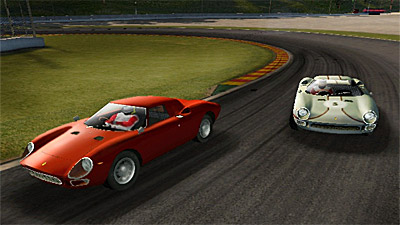
There are “assists” available on the options screen, and one can adjust each from Off (0) to Max (5) – with these turned up, the car does a better job of keeping balanced, gripping the road, and braking. Here, one can also toggle the racing line and switch to manual transmission. Turning the assists down will garner extra “difficulty” points in the race modes.
Unfortunately, the game doesn’t create much sense of speed. Turning the assists down helps with this and makes the car feel more alive and responsive in general, but the problem then is that one can hardly accelerate, brake, or steer without sending the vehicle hurtling off the track. Then again, even with the assists fully cranked, this is pretty much the case for the first couple hours, anyway.
It’s best to focus on the racing line, a green-colored path that turns to red as a corner approaches. That’s right: the game maps out every turn, acceleration, and brake, and it’s still remarkably difficult.
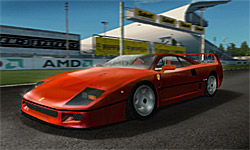
Once all this practice is over – assuming the Wii-mote and television have survived any violent incidents, and assuming neighbors haven’t called the police to report high-volume curse words – it’s time to tackle the game’s five (yes, five) race modes.
The unlocking system serves as the common thread. By completing (or better yet, winning) races, the player earns “Challenge Cards” and points. Somewhat stupidly, both are necessary to unlock cars – each card makes a new Ferrari available for purchase with points. The physics model adjusts to the various cars’ handling, and for the game’s target audience, diehard “Prancing Pony” fans, this will no doubt be a thrilling experience.
At least it had better be, because the Ferrari license degrades the game’s realism big-time in the race modes; the cars do not take damage beyond a scratch or a lost bumper. If you drive headlong into a wall, ram other cars out of the way, whatever, there’s no damage and no effect on handling. It’s no shocker that the company wanted to protect its image, and other licensed racing games do the same thing, but it’s ridiculous all the same and kills the immersion.
Challenge mode, in which players tour Italy, Europe, and North America in an imitation of the real-life Ferrari Challenge, forms the game’s heart. Most of the races are pretty manageable after the tutorial, though it’s infuriating to realize it didn’t cover a necessary and difficult technique: using the handbrake to skid. Passing is another harrowing experience, especially as the game progresses and the A.I. gets more aggressive.
The races are far too long – in the 10-to-15-minute range, usually. Because of the game’s commitment to realism, all the cars in the Ferrari Challenge are F430s, and there’s no (apparent) rubber banding. This means passing is rare, and once one is far enough in last or first place, it gets lonely and boring. One half hopes for Princess Peach to smash the car with a red shell, just to liven things up.
While only the F430 is available in Challenge mode, there are plenty of cards and points to earn. In Trophy mode, some of the cars unlocked and purchased with these goodies have their own three-race tours. Time Trial is just what it sounds like, with the unlocked cars available to run each track.
Arcade mode includes four tours of four races each. The completion of each tour in or above the targeted position unlocks the next. It’s fun, and there are (again) points and cards to win, but the races are just as long as they are elsewhere, and there’s no way to save between races.
The game’s most fun mode is Quick Race. Unfortunately, the only tracks and cars available are the ones unlocked in other modes, but it’s possible to set the number of laps, the number of opponents, and even the weather – with “wet,” the race takes place under a moody, overcast sky, though the rain effects aren’t as impressive as in the PS3 version. Unfortunately, there’s no option for a night or, say, snowy race.
When it comes to multiplayer, Ferrari Challenge really drops the ball: there is none, which is annoying, because the PS3 version has an online mode. Relative to the PS3, the Wii also loses out on DLC packages featuring every Ferrari ever made – hardly a surprise, given the Wii’s lack of a hard drive.
For the Wii owner who loves no-frills racing simulations, doesn’t also own a PS3, and wants to be run over by a Ferrari and then buried in its driver’s seat, this is the perfect game – there’s no telling, between all five modes, how long such a person could stay entertained. For Wii owners who love racing sims and don’t have other consoles, this is the only game in town. Otherwise, forget about it.
RATING OUT OF 5 RATING DESCRIPTION 3.2 Graphics
The visuals aren’t so bad as to disrupt the experience, and there’s a nice touch here and there, but there’s nothing amazing, even by Wii standards. 3.7 Control
They’re difficult, but by design. The game makes good use of motion-control steering, but purists will find shifting in manual mode frustrating. 3.2 Music / Sound FX / Voice Acting
Good engine roar, wimpy crash sounds, odd (but low-volume) music. 3.9
Play Value
It’s definitely not the game for everyone, but those who get into it could take days exploring it.
3.4 Overall Rating – Fair
Not an average. See Rating legend above for a final score breakdown.
Game Features:
